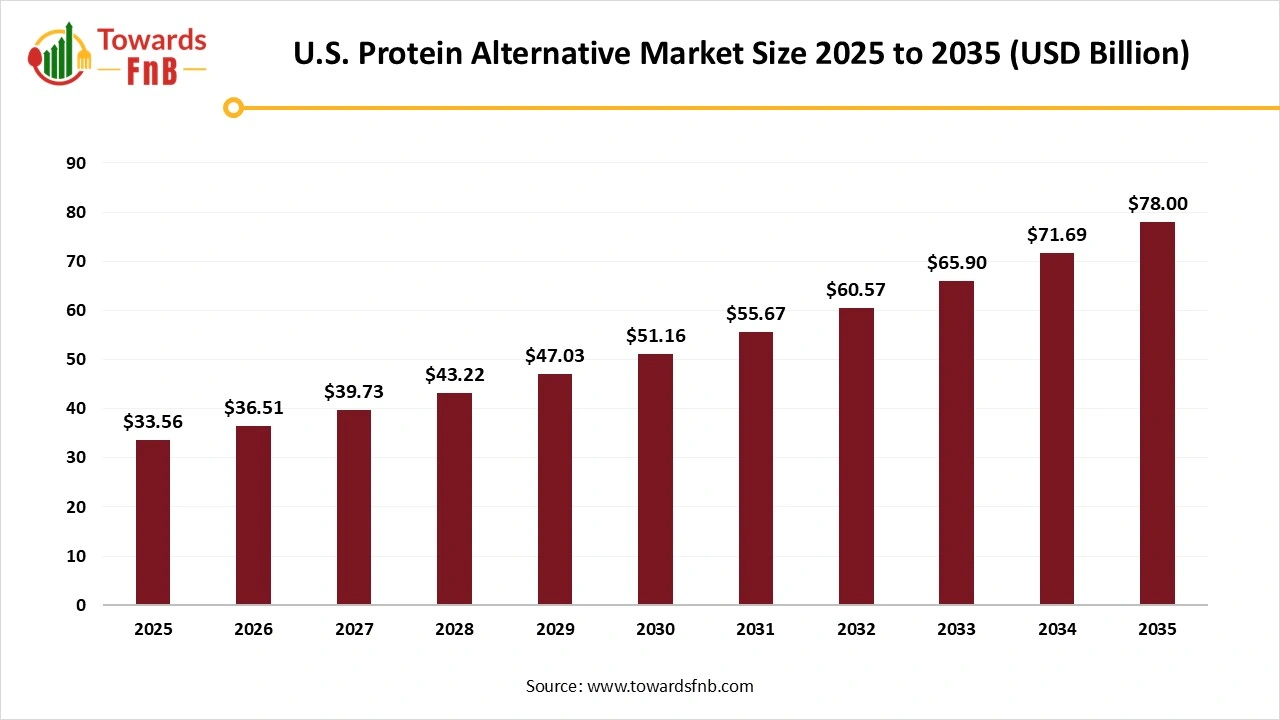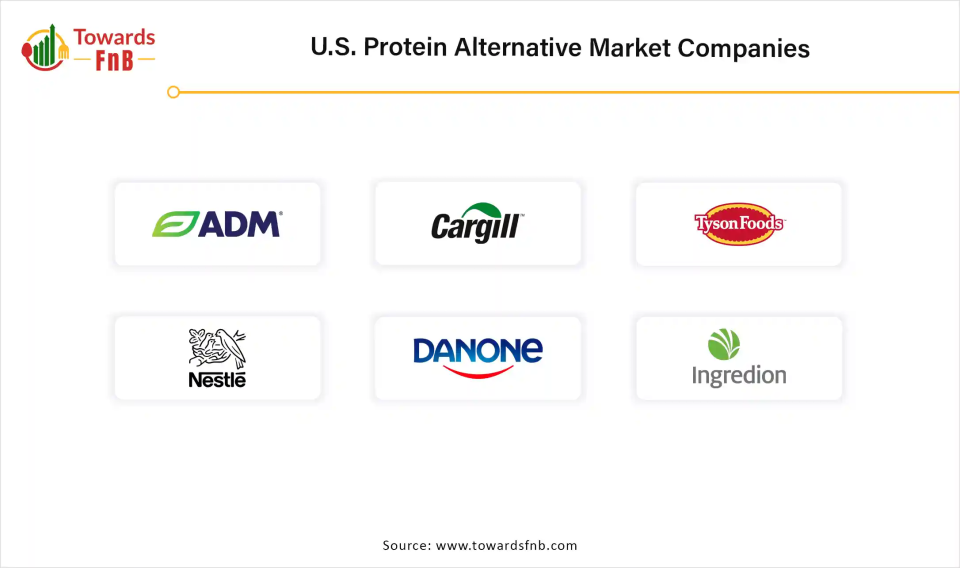January 2026
The U.S. protein alternative market size reached at USD 33.56 billion in 2025 and is expected to grow steadily from USD 36.51 billion in 2026 to reach nearly USD 78 billion by 2035, with a CAGR of 8.8% during the forecast period from 2026 to 2035. The growth of the market is attributed to the increasing demand for vegan diets and protein rich foods which may enhance consumer’s health and wellness.

| Study Coverage | Details |
| Growth Rate from 2026 to 2035 | CAGR of 8.8% |
| Market Size in 2026 | USD 36.51 Billion |
| Market Size in 2027 | USD 39.73 Billion |
| Market Size by 2035 | USD 78 Billion |
| Base Year | 2025 |
| Forecast Period | 2026 to 2035 |
The U.S. protein alternative market refers to the industry involved in the production, processing, and commercialization of protein sources that serve as alternatives to conventional animal-based proteins. These proteins are derived from plants, microbes, insects, or cultured cells and are designed to meet the growing consumer demand for sustainable, ethical, and health-conscious protein options.
The market encompasses products for human consumption, animal feed, clinical nutrition, and other applications, catering to dietary preferences, environmental concerns, and food security needs. In addition, the market is also driven by factors such as the increasing awareness towards vegan diets, increasing demand for healthy products with protein content, increasing industrial livestock production, increasing demand for beef and increasing consumption of protein rich diets for poultry, which further drives the market for protein alternative during the forecast period.
One of the major opportunities revolutionizing market growth is the rising integration of artificial intelligence. By streamlining commercialization and product innovation, artificial intelligence is revolutionizing market growth. To improve flavor, texture and nutritional value of proteins, AI leverages huge database. This enables tailored solutions that address consumer demand. The rising integration of advanced technologies, like data analytics, AI and Internet of Things are also allowing highly efficient, waste-reducing and smarter procedures.
In addition, ensuring data transparency and privacy in artificial intelligence remains crucial, to gain consumer trust. AI-generated platforms further enhance the creation of sustainable protein alternatives. These advanced factors are expected to revolutionize the growth of the U.S. protein alternative market in the coming years. AI-generated platforms further enhance the creation of sustainable protein alternatives.
One of the major challenging factors restraining market growth is the increasing high products costs. Alternative protein often need expensive and complex processing and extraction methods, leading to higher production costs. Scaling up manufacturing to address products market demand can be costly and challenging, which may further affect the cost-effectiveness of alternative proteins, which is further expected to restrain the growth of the U.S. protein alternative market.
The market growth in the region is attributed to the rising advancements in food technology. Increasing demand for vegetarians and vegan diets, rising consumer demand towards healthy and sustainable food options, and increasing government supportive initiatives and policies.
The country’s growth is driven by the increasing health awareness towards plant-based diets, increasing consumer awareness towards the significant food options, and growing sustainability. Approximately 138 of the 216 US ecosystems, 50% shift toward alternative proteins in the U.S. can enhance the restoration of cropland. An annual carbon sequestration opportunity of 177.8 million metric tons (MMT) of CO₂ equivalent, by improving land use efficiency and enabling the restoration of croplands to forests, which expected to drive the market growth in the U.S.
How do Plant-based Protein Segment Dominates U.S. Protein Alternative Market Revenue in 2025?
The plant-based protein segment dominated the market revenue in 2024. The segment growth in the market is attributed to the various benefits such as reduced risk of chronic diseases, improved gut health and digestion, enhanced weight management, reduce carbon footprint, improved food safety, increasing awareness about animal welfare and increasing consumer preference towards clean-label and organic food products. The retail plant-based food dollar sales were 8.1 billion in the U.S. in 2023. In 2023, 81% of households purchased plant-based foods, and plant-based milk held 15% market revenue of total milk dollar sales in 2023. In addition, according to the GFI’s analysis of data from the Net Zero Insights platform, plant-based dairy companies, eggs, seafood, and meat companies raised 907.7 million in 2023. These factors are expected to drive the segment growth in the market.
The Microbial-Based Protein Segment is Expected to Grow Fastest During the Forecast Period
The segment growth in the U.S. protein alternative market is driven various benefits such as increasing consumer awareness related to the environmental and health benefits, increasing the wide range of applications such as dietary supplements and sports nutrition, increasing adoption of nutritional profiles, increasing source of sustainable protein, enhanced nutritional value, reduced environmental impact, growing population and increasing dietary preferences.
Why do the Dry Form Segment Held the Largest U.S. Protein Alternative Market Revenue in 2025?
The dry form segment dominated the market revenue for protein alternative in 2025. The segment growth in the market is driven by factors such as increasing convenience and versatility, reducing spoilage and waste, increasing shelf life, increasing cost-effectiveness, and reduced transportation costs for manufacturers. In addition, due to cost-effectiveness, convenience and versatility, the dry form of proteins such as dehydrated products and powders plays an important role in the protein alternative in the market.
The Liquid Form Segment is Expected to Grow Fastest During the Forecast Period
The segment growth in the U.S. protein alternative market is driven by various benefits such as increasing protein stabilization which maintain efficacy and prevent degradation, increasing moisture and fat in a liquid form which maintain taste and texture, increasing demand for specific nutritional needs, increasing versatility in application, enhanced absorption and digestibility, increasing demand for ready-to-mix and ready-to-drink protein beverages and increasing busy and changing lifestyles.
What Factors Help Food and Beverage Segment Grow in 2025?
The food and beverages segment dominated the U.S. protein alternative market revenue in 2025. The segment growth in the market is attributed to the factors such as the increasing demand for sustainable and ethical sources of food, rising consumer preference towards flexitarian and plant-based diets, increasing consumption of meat alternatives and dairy-free drinks, and increasing environmental sustainability. In addition, the liquid form of protein alternative to address the challenges related to consumer scalability, cost and acceptance and providing a various range of food security and human health, which is further expected to drive the segment growth.
The Clinical Nutrition Segment Expects the Fastest Growth During the Forecast Period
Protein alternatives such as insect-based proteins, fermented proteins and plant-based proteins play an important role in clinical nutrition. The segment growth in the U.S. protein alternative market is driven by various benefits such as promoting sustainability, improving muscle health, reducing chronic diseases and addressing protein-energy malnutrition.
How Retail Channel Segment Dominates U.S. Protein Alternative Market Revenue in 2025?
The retail channel segment dominated the market revenue for protein alternative in 2025. The segment growth in the market is attributed to the factors such as increasing demand for offline stores, increasing consumer desire to shop offline without waiting for online delivery, increasing accessibility and visibility, increasing potential for impulse purchases, increasing consumer trust and brand awareness, enhancing product innovation, addressing consumer preferences and increasing adoption of high-protein food products.
The Food Services Segment is Expected to Grow Fastest During the Forecast Period
The segment growth in the U.S. protein alternative market is attributed to the factors such as growing e-commerce platforms, increasing integration of internet, increasing changing and modern lifestyles, reducing risk of disease transmission, enhanced nutritional profiles and increasing environmental sustainability.
Mario West

By Source
By Form
By Application
By Distribution Channel
January 2026
January 2026
December 2025
December 2025